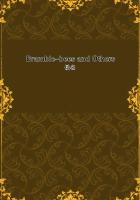Every syllogism is effected by means of three terms. One kind of syllogism serves to prove that A inheres in C by showing that A inheres in B and B in C; the other is negative and one of its premisses asserts one term of another, while the other denies one term of another. It is clear, then, that these are the fundamentals and so-called hypotheses of syllogism. Assume them as they have been stated, and proof is bound to follow-proof that A inheres in C through B, and again that A inheres in B through some other middle term, and similarly that B inheres in C. If our reasoning aims at gaining credence and so is merely dialectical, it is obvious that we have only to see that our inference is based on premisses as credible as possible: so that if a middle term between A and B is credible though not real, one can reason through it and complete a dialectical syllogism. If, however, one is aiming at truth, one must be guided by the real connexions of subjects and attributes. Thus: since there are attributes which are predicated of a subject essentially or naturally and not coincidentally-not, that is, in the sense in which we say 'That white (thing) is a man', which is not the same mode of predication as when we say 'The man is white': the man is white not because he is something else but because he is man, but the white is man because 'being white' coincides with 'humanity' within one substratum-therefore there are terms such as are naturally subjects of predicates. Suppose, then, C such a term not itself attributable to anything else as to a subject, but the proximate subject of the attribute B--i.e. so that B-C is immediate; suppose further E related immediately to F, and F to B. The first question is, must this series terminate, or can it proceed to infinity? The second question is as follows: Suppose nothing is essentially predicated of A, but A is predicated primarily of H and of no intermediate prior term, and suppose H similarly related to G and G to B; then must this series also terminate, or can it too proceed to infinity? There is this much difference between the questions: the first is, is it possible to start from that which is not itself attributable to anything else but is the subject of attributes, and ascend to infinity? The second is the problem whether one can start from that which is a predicate but not itself a subject of predicates, and descend to infinity? A third question is, if the extreme terms are fixed, can there be an infinity of middles? I mean this: suppose for example that A inheres in C and B is intermediate between them, but between B and A there are other middles, and between these again fresh middles; can these proceed to infinity or can they not? This is the equivalent of inquiring, do demonstrations proceed to infinity, i.e. is everything demonstrable? Or do ultimate subject and primary attribute limit one another?
I hold that the same questions arise with regard to negative conclusions and premisses: viz. if A is attributable to no B, then either this predication will be primary, or there will be an intermediate term prior to B to which a is not attributable-G, let us say, which is attributable to all B-and there may still be another term H prior to G, which is attributable to all G. The same questions arise, I say, because in these cases too either the series of prior terms to which a is not attributable is infinite or it terminates.
One cannot ask the same questions in the case of reciprocating terms, since when subject and predicate are convertible there is neither primary nor ultimate subject, seeing that all the reciprocals qua subjects stand in the same relation to one another, whether we say that the subject has an infinity of attributes or that both subjects and attributes-and we raised the question in both cases-are infinite in number. These questions then cannot be asked-unless, indeed, the terms can reciprocate by two different modes, by accidental predication in one relation and natural predication in the other.















